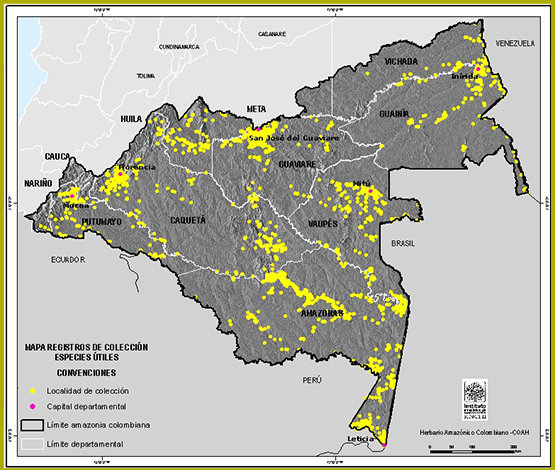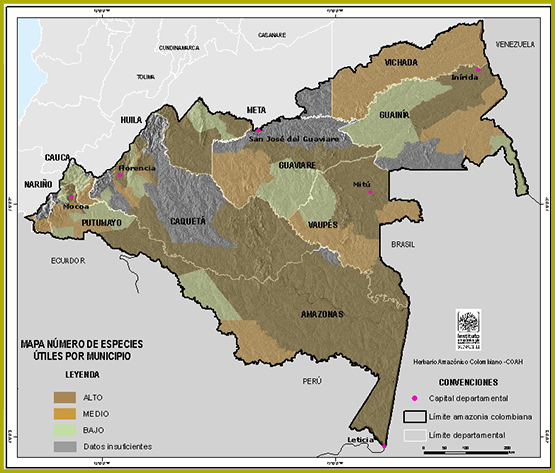| Porcentage of species by number of uses | |||||
| Number of uses | Porcentage | Number of uses | Porcentage | Number of uses | Porcentage |
| 1 | 65.6% | 3 | 9.6% | 5 | 0.5 |
| 2 | 22.2% | 4 | 1.9% | 6 | 0.1% |
During the development of research carried out by the Amazon Flora Program of the SINCHI Institute, 1159 useful species belonging to 150 botanical families have been identified for the entire Amazonian region of Colombia. The collection is classified into 12 categories of use corresponding to: food, medicine, artisanal, fodder, psychotropic, toxic, ornamental, magical, fuel, sawmill, construction, dye and industrial. The percentage of species that have at least one identified use is presented in the table. The graph shows the number of records with at least one use category and the map shows the distribution of species with at least one use category.
{indicador_5}

Useful plants by biome
The records of useful species are found in greater numbers in the biomes of Zonobiome Humid Tropical Amazonia-Orinoquia-ZBHT-AO with a percentage of 45%, in second place Helobioma Amazonia-Orinoquia-H-AO 30% and Litobiome Amazonia-Orinoquia- L-AO with 15% as the most representative, in the graph the percentages of useful species for each of the biomes are presented.
{indicador_6}
Species by category of use and by biome are represented in the graph, where it can be observed that the medicinal use (23%), timber (19%) and food (18%), are the most frequent for the species of the region. The map represents the number of useful species per biome, highlighting the Humid Zonobiome Tropical Amazonia-Orinoquia-ZBHT-AO and the Helobiome Amazonia-Orinoquia-H-AO with a greater number of useful species.
{indicador_8}

Useful plants by Department and Municipality
As for the departments, Amazonas stands out with the highest percentage of records of useful species (40%) corresponding to 843 species, Caqueta (17.9%) with 754 species and Putumayo (10.9%) with 466 species
{indicador_4}
As shown in the map, the municipalities that stand out for their high number of useful species are: Puerto Santander (628 species) and Miriti Parana (505 species) of Amazonas; Solano (602 species) and Florencia (223 species) of Caqueta; Inirida (194 species) of Guainía; San Jose of Guaviare (389 species) and El Retorno (198 species) of Guaviare; La Uribe (237 species) and La Macarena (228 species) of Meta; Mocoa (307 species) and Puerto Leguízamo (237 species) from Putumayo and Taraira (185 species) and Mitu (179 species) from Vaupes.

Headquarters Leticia: avenida Vásquez Cobo between calle15 AND 16
Florencia office: calle 31A # 2e 11 Los Pinos
San José del Guaviare office: calle 10 # 25a 06 Barrio El Dorado
Mitu sub-office: carrera 14 # 10 - 37 Centro
Puerto Leguízamo work station: carrera 3 N° 2 - 19, Barrio Centro
Puerto Asis sub-office: carrera 30 # 9 - 118 Barrio Modelo
Línea Anticorrupción:
[email protected]
Whistleblower channel
Bogotá office: calle 20 # 5 - 44
Phone: +57 (601) 4442060
Inírida sub-office: calle 21 # 9 - 22 Barrio Los Comuneros
office hours:
monday to friday from 7 a.m. to 12 p.m. and from 2-5 p.m.
office hours:
monday to friday 8 a.m. to 5 p.m.
E-MAIL: [email protected]
(los asuntos de carácter judicial serán igualmente atendidos por este correo electrónico)





